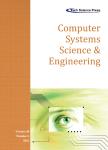A Component Selection Framework of Cohesion and Coupling Metrics
作者机构:Department of Computer Science and EngineeringSRM UniversityDelhi-NCRSonepat131029India Department of Computer ScienceCollege of Computer Engineering and SciencesPrince Sattam Bin Abdulaziz UniversityAlkharj11942Saudi Arabia School of SciencesChrist(Deemed to be University)Delhi-NCRGhaziabad201003India Department of Computer ScienceCollege of Computers and Information TechnologyTaif UniversityP.O.Box 11099Taif21944Saudi Arabia Department of Information TechnologyCollege of Computers and Information TechnologyTaif UniversityP.O.Box 11099Taif21944Saudi Arabia
出 版 物:《Computer Systems Science & Engineering》 (计算机系统科学与工程(英文))
年 卷 期:2023年第44卷第1期
页 面:351-365页
核心收录:
学科分类:08[工学] 0812[工学-计算机科学与技术(可授工学、理学学位)]
基 金:We deeply acknowledge Taif University for Supporting this research through Taif University Researchers Supporting Project number(TURSP-2020/231) Taif University Taif Saudi Arabia
主 题:Component-based software system coupling metric cohesion metric complexity component interface module density
摘 要:Component-based software engineering is concerned with the develop-ment of software that can satisfy the customer prerequisites through reuse or inde-pendent *** and cohesion measurements are primarily used to analyse the better software design quality,increase the reliability and reduced system software *** complexity measurement of cohesion and coupling component to analyze the relationship between the component *** this paper,proposed the component selection framework of Hexa-oval optimization algorithm for selecting the suitable components from the *** measures the interface density modules of coupling and cohesion in a modular software *** cohesion measurement has been taken into two parameters for analyz-ing the result of complexity,with the help of low cohesion and high *** coupling measures between the component of inside parameters and outside *** process of coupling and cohesion,the measured values were used for the average calculation of components *** paper measures the complexity of direct and indirect interaction among the component as well as the proposed algorithm selecting the optimal component for the *** better result is observed for high cohesion and low coupling in compo-nent-based software engineering.



